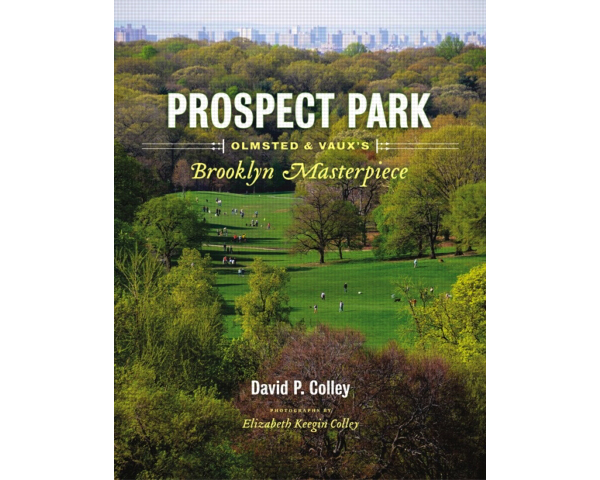
Author: David P. Colley, photographs by Elizabeth Keegin Colley (Princeton Architectural Press, 2013)
We are spoiled in Metro Vancouver. With so many wonderful urban parks at our fingertips – from Stanley Park to Cates Park, Holland Park to Confederation Park – it is easy for us to dismiss similar spaces from a different part of the world.
I, for one, have always had difficulty understanding the excitement and clamour around the many popular parks in New York City. Having never visited the NYC area, I could never truly get a sense of what made places such as Central Park and Prospect Park so significant, despite being constantly bombarded with their importance through mass media culture. As I began reading Prospect Park: Olmsted & Vaux’s Brooklyn Masterpiece the larger picture began to sink in, however. Instantaneously lost within the two-page spreads of magnificent trees and winding trails, I began to see why the parks designed by two of the best landscape designers of this past generation, stand towering above other similar parks.
The book is simple in is organized chronologically, from oldest information to the most recent. It is, in no other way, a historical guide through the trials and tribulations of Prospect Park. As such, it never reads solely as a history book. There are facts and dates, but the authors manage to seamlessly integrate the mundane details within a larger poetic story, exciting the reader to delve more deeply into the information.
We start with The Beginning, an introduction and overview that highlights certain key things to know about Prospect Park. In chapter two, we are handed extraordinary character sketches of Stranahan, Vaux, and Olmsted – a fascinating and wonderfully written account of men who were not legends during their time, but were prominent individuals in their own right.
Chapter three focuses on The Olmsted and Vaux Plan which was a contentious subject for many people shortly after the building of Central Park (also Olmsted and Vaux), and this chapter does not fail to disappoint in describing the relationship between both.
The last three chapters focus on the park after Olmsted and Vaux and how technological advances and societal changes affected Prospect Park. Thus, in Chapter four – The Delight of the Park – readers are shown a serene picture of the park before the turn of the 20th century as a place where everyone was welcome, and life was easy. Breaks from the busy and chaotic streets could be found between large trees and in the long meadows, or strolling through paths in a horse drawn carriage. As this chapter comes to a close, readers begin to see the cracks in the foundation of the park as regimes change and new management takes over.
This segues masterfully into The New Deal and Beyond which speaks to the decline of the park in response to the egos of architects, the love affairs of city officials, racism, crime, and (like many other seemingly unrelated events…) the invention of the automobile. The park soon fell into heavy disarray, with some of its few pieces of ornamentation being stolen in the night, original architectural buildings designed by Vaux burned down mysteriously, violent attacks, and the portrayal by media of Brooklyn as a terrible place to be. Eventually, money stopped flowing, and no one had the time or will to work on the park the way it had been maintained years prior, despite being an integral piece of the Brooklyn’s urban fabric.
Finally, Chapter Six focuses on the park being Reclaimed and Restored, something decades in the making. The massive effort to set things right began in the 1970’s, and while many of the efforts to restore the park are completed and it is once again a shining example of landscape achievement, the work is never done, according to the city park managers. As with many urban parks, the maintenance of Prospect Park is constant, but the city of Brooklyn has now taken back the pride they felt for the park almost one hundred and fifty years ago, upon its idyllic conception. A fact that is wonderful for Brooklyn residents as well as those of us who will (one day) get to visit this stunning park.
Overall, Colley never had me struggling to maintain focus throughout the book. The gangsters, the drugs, the civic arguments, the media trash talk and the slamming of architectural and spatial values through public address was a wildly entertaining ride.
Yet, the message it simple: to think that a park is just a collection of grass, trees and other plants, with the occasional bench or bridge over a bubbling creek, is to miss the point entirely. Parks spaces done well are more than the sum of their parts. Prospect Park: Olmsted & Vaux’s Brooklyn Masterpiece eloquently tells the story of of one such place.
***
For more information on the book, visit the Princeton Architectural Press website.
**
Jeremy Senko is happily lost in the world of theoretical architecture and design. He is forever a student at heart, consistently reading, experiencing and learning about the world he inhabits. More specifically, he recently completed his Bachelor of Interior Design at Kwantlen Polytechnic University, where he pushed the limits (and the patience) of his professors.

